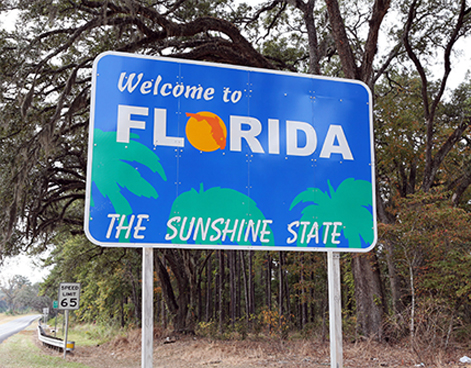
Florida Overview
Florida continues to be a destination for businesses, workers, and retirees. With a booming economy, population,
business-friendly environment, and lifestyle, the state is attracting investors, developers, and lenders.
Its population growth is national news—the fastest-growing state in 2022 for the first time since 1957.
The population has surpassed 22 million, with 3.1 million people moving in during the previous decade,
says the Tampa Bay Times. Between 2020 and 2022, a period marked by a pandemic, only Texas grew faster
in population, as Florida added more than 655,000 residents.
Florida’s economy is also growing, and its cities are earning top reviews:
• Employment continued to be strong in June 2023, according to Florida Commerce.
The labor force grew by 2.4%, faster than the U.S. average of 1.8%.
The private sector increased hiring at a quicker pace than the national average, as well.
• According to Florida Commerce, as of June 2023, compared to the nation’s other nine largest states,
Florida has enjoyed the lowest unemployment rate for 13 consecutive months.
At 2.6%, Florida’s unemployment rate is a full percentage point lower than the national figure.
Florida’s unemployment rate also has remained lower than the national rate for 32 consecutive months.
• In the first four months of 2023, 158,088 new businesses have formed in Florida, more than any other state in the nation, per Florida Commerce.
• Five Florida cities have made the 2023-2024 list of best places to live in the United States,
according to U.S. News & World Report. They are spread across the state with Sarasota (5), Naples (6), Melbourne (15), Jacksonville (16), and Tampa (24).
• U.S. News & World Report put Davenport, Freeport, and Westlake on its list of popular small U.S. towns to live in.
With business booming and the state‘s population growing, it no wonder that the housing market remains healthy in Florida.
New construction is driving the market, accounting for nearly one in three single-family home listings during the second quarter of 2023,
according to Redfin. The listing increases were spread across the state, from Jacksonville to Miami, and over to Cape Coral and Tampa.
Most of the action was on the west coast, says HBW (Home Builders Weekly website) .
Continued demand for homes, coupled with builders stepping up operations, makes Florida ideal for real estate investment.
BAI Capital says that Florida is the best place to put money into real estate. According to Benoit Properties International,
North Port, Port Charlotte, and nearby areas in southwest Florida are hotspots for investment.
Further, the Jacksonville Daily Record says, “Jacksonville is a great city for real estate investing because of the combination
of low home prices, high rental rates, and high property appreciation.”
TAMPA & TARPON
Address: ANCLOTE RD
City: TARPON SPRINGS
Zip: 34689
Folio: 01/27/15/89136/000/0450
Property Type: Vacant Land
SqFt: 1,044,155
Pinellas County is a county located in the state of Florida. As of the 2010 census, the population was 916,542. Its county seat is Clearwater, and its largest city is St. Petersburg. Wikipedia

